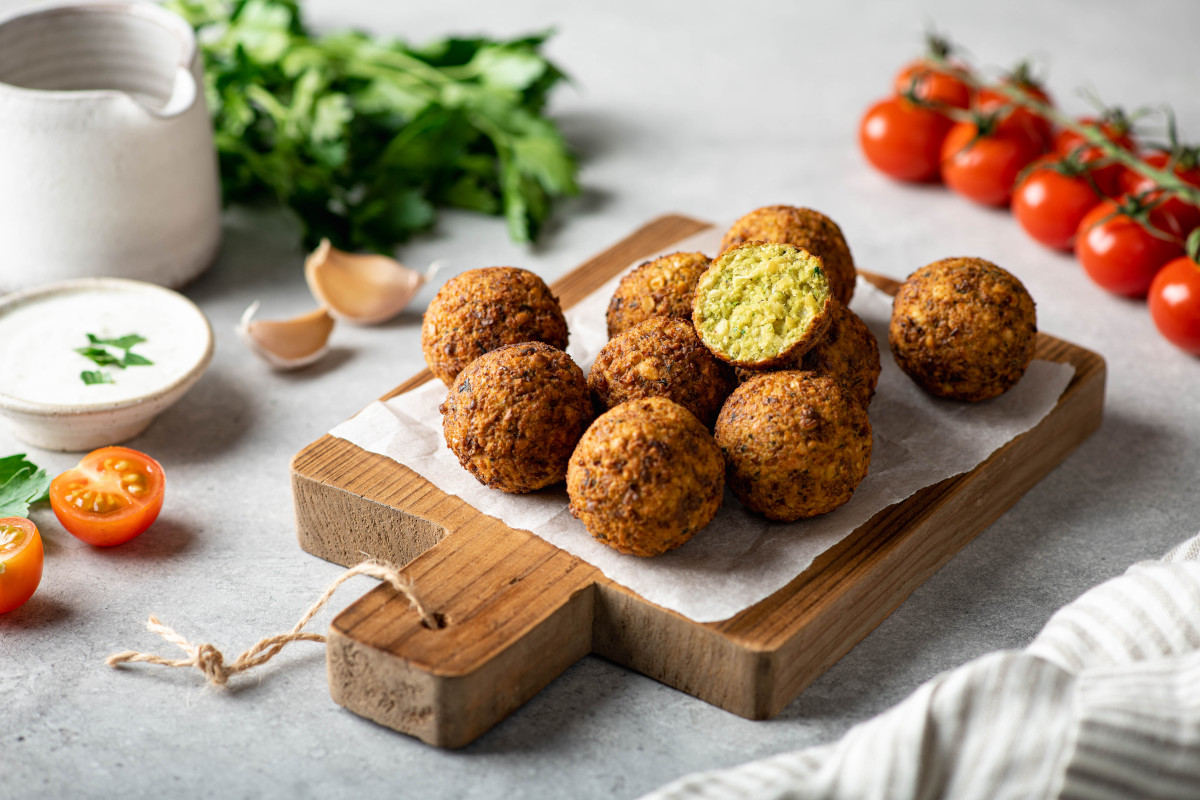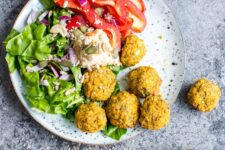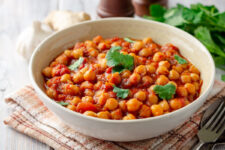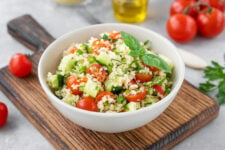Savory and crispy, falafel is a popular Middle Eastern recipe primarily made of fava beans or chickpeas. It’s enjoyed worldwide and is a common vegetarian menu item.

What exactly is Falafel?
Falafel is made by grinding the beans with various herbs and spices, including garlic, cumin, and parsley. The mixture, often green due to the parsley, is rolled into balls or small patties and traditionally deep-fried to attain a golden color and crispy outer crust.
You’ll likely find falafel served in a pita or as an appetizer. It’s commonly enjoyed in restaurants and is also a well-loved street food.
Falafel is a popular vegetarian alternative to meat-based Middle Eastern dishes and is even available in frozen or packaged form at the grocery store. It’s also reasonably simple to prepare falafel from scratch at home using a food processor.
With all the different ways to prepare and consume falafel, you may have wondered if falafel is healthy. Learn more about the health benefits of falafel and how to make falafel healthier.
Is Falafel Healthy?
Depending on how it’s prepared, falafel can be a healthy plant-based protein option while providing a good source of fiber, vitamins, and minerals. The traditional preparation method of deep-frying the falafel makes the dish high in fat and calories, which you can significantly reduce by baking the falafel instead.
Like other deep-fried foods, deep-fried falafel can lead to numerous health risks if eaten often. In particular, frequent fried food consumption is associated with an increased risk of cardiovascular disease (1).
The increased calories from preparing falafel in a deep fryer can also be problematic for people concerned about weight. Further, restaurant falafel, as well as store-bought packaged falafel, is often very high in sodium.
Luckily, there are ways to make falafel healthier. The core ingredients in falafel are quite nutritious, so if it is not deep-fried, it can be a very healthy vegetarian option.
The healthiest way to prepare falafel is to bake it, which significantly reduces the fat and calorie content while still producing a crispy patty. The next best option would be to pan-fry the falafel in a thin layer of oil rather than deep-frying it.
Serving falafel on top of a green salad with a yogurt tzatziki sauce and a side of pita bread is a delicious and nutritious way to lighten up the meal.
Health Benefits of Falafel
Most of the health benefits of falafel come from the primary ingredient: legumes. Chickpeas and fava beans are the most popular choices for falafel, often used in combination.
Legumes are a good source of plant protein, fiber, vitamins, and minerals. They provide numerous health benefits, including a reduced risk of heart disease, cancer, type 2 diabetes, and obesity (2).
Falafel can be a great way to include more legumes in your diet to help reach the recommendation of eating 3 cups of legumes per week.
Nutrition facts
The nutrition content of falafel varies greatly depending on the size of the patties and how they are prepared (3, 4). Specifically, the calories, fat, and sodium content vary most between preparation methods.
A serving of 5-6 average-sized falafel patties contains (3):
- 333 calories
- 13 g of protein
- 32 g of carbohydrates
- 5 g of fiber
- 18 g of fat
- 294 mg of sodium
- 3.4 mg of iron
- 82 mg of magnesium
- 192 mg of phosphorus
- 585 mg of potassium
- 1.5 mg of zinc
Falafel also contains numerous B vitamins, including folate, vitamin B6, riboflavin, and thiamin.
Plant protein source
Falafel is an excellent source of plant-based protein, making it a popular option among vegetarians and vegans. At 13 grams of protein per serving, falafel can help you meet your daily protein needs.
Increasing your intake of plant proteins, especially when eaten in place of red meat, is known to help lower cholesterol levels, blood pressure, and risk of cardiovascular disease (2).
Fiber source
Falafel is an good source of complex carbohydrates. With approximately 5 grams of fiber per serving, falafel provides 20% of the daily minimum fiber recommendation (5).
The type of fiber in chickpeas is particularly beneficial.
Studies show that including chickpeas in a meal increases satiety, and regular consumption can improve gut health and digestion (6). Regularly consuming chickpeas can also help with weight management and blood sugar regulation (7).
Additionally, fava beans are rich in antioxidants and are associated with lower blood sugar, blood pressure, cholesterol, and inflammation (8).
Allergies and Risks
You may be wondering if falafel is safe to include in your diet. For most individuals, the answer is yes―falafel is generally well tolerated and works well for many dietary restrictions.
Falafel is naturally vegetarian and vegan, though it’s often served with sauces and condiments that are not vegan, like yogurt-based tzatziki sauce.
Falafel can also be made gluten-free if chickpea flour is used instead of wheat flour. However, if you have celiac disease, care must be taken to avoid cross-contamination in the restaurant setting because the frying oil used to make the falafel may also be used for gluten-containing items.
If you have an allergy to sesame seeds, one of the top nine allergens, be cautious with falafel. Sesame seeds are commonly used inside the chickpea mixture or to top the falafel.
People with irritable bowel syndrome may have difficulty digesting legumes and often need to limit their intake. Since falafel is primarily made up of legumes, the portion size may need to be limited to avoid digestive upset and gas.
More rare is a genetic condition called G6PD deficiency or favism. People with this disorder can become very sick if they consume fava beans. Since falafel often contains a mixture of chickpeas and fava beans, it’s best to stick with homemade falafel made from chickpeas only if you have this condition (9).
Healthy Baked Falafel
Ingredients
- 15 oz chickpeas one can, drained and rinsed
- 1 onion small, chopped
- 1/2 cup parsley fresh, chopped
- 1/2 cup cilantro fresh, chopped
- 3 cloves garlic minced
- 1 tsp ground cumin
- 1 tsp ground coriander
- 1/2 tsp ground paprika
- 1/2 tsp ground cinnamon
- 1/4 tsp ground black pepper
- 1/4 tsp cayenne pepper optional
- 1 tsp salt
- 2 tbsp all-purpose flour or chickpea flour for gluten-free
Instructions
- Preheat oven to 400°F. Line a baking sheet with parchment paper.
- In a food processor, combine the chickpeas, onion, parsley, cilantro, garlic, cumin, coriander, paprika, cinnamon, black pepper, cayenne pepper (if using), and salt. Pulse until the mixture is finely ground.
- Add the flour to the chickpea mixture and pulse a few times. The mixture should hold together when formed into a ball. If it's too dry, add a little water, a tablespoon at a time, until desired consistency is reached.
- Shape the mixture into balls or patties and place them on the prepared baking sheet. If you don't mind a little bit of oil, you can brush the tops with olive oil for extra flavor.
- Bake the falafel for 15-20 minutes, or until they are lightly browned and firm to the touch.
- Serve hot with pita bread, vegetables, sauce, or on a bed of rice or salad.
Notes
- You can store leftovers in an airtight container in the refrigerator for up to 3 days, or in the freezer for up to 3 months.
- To reheat, bake the falafel in a 350°F oven for about 10-15 minutes, or until they are heated through.







